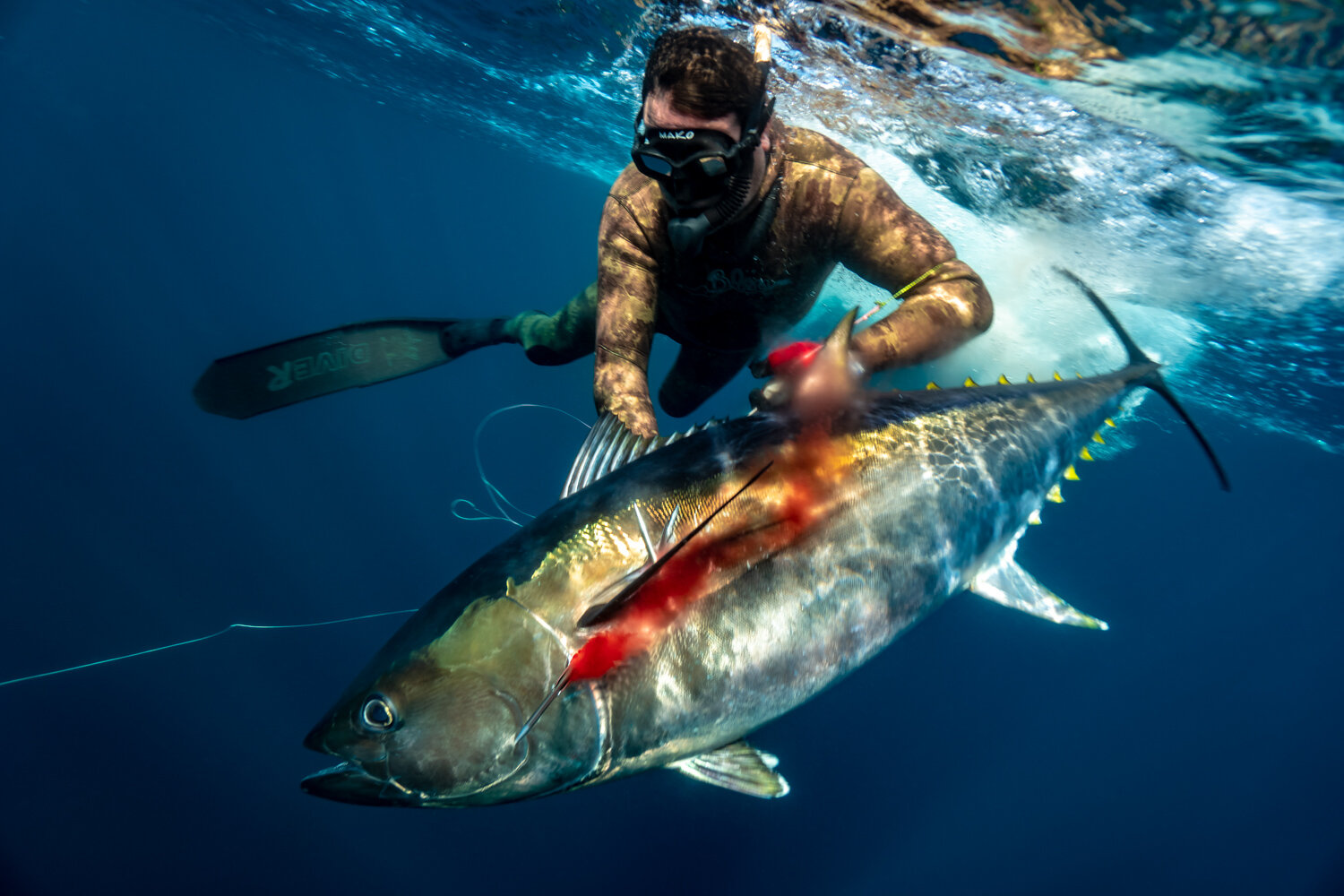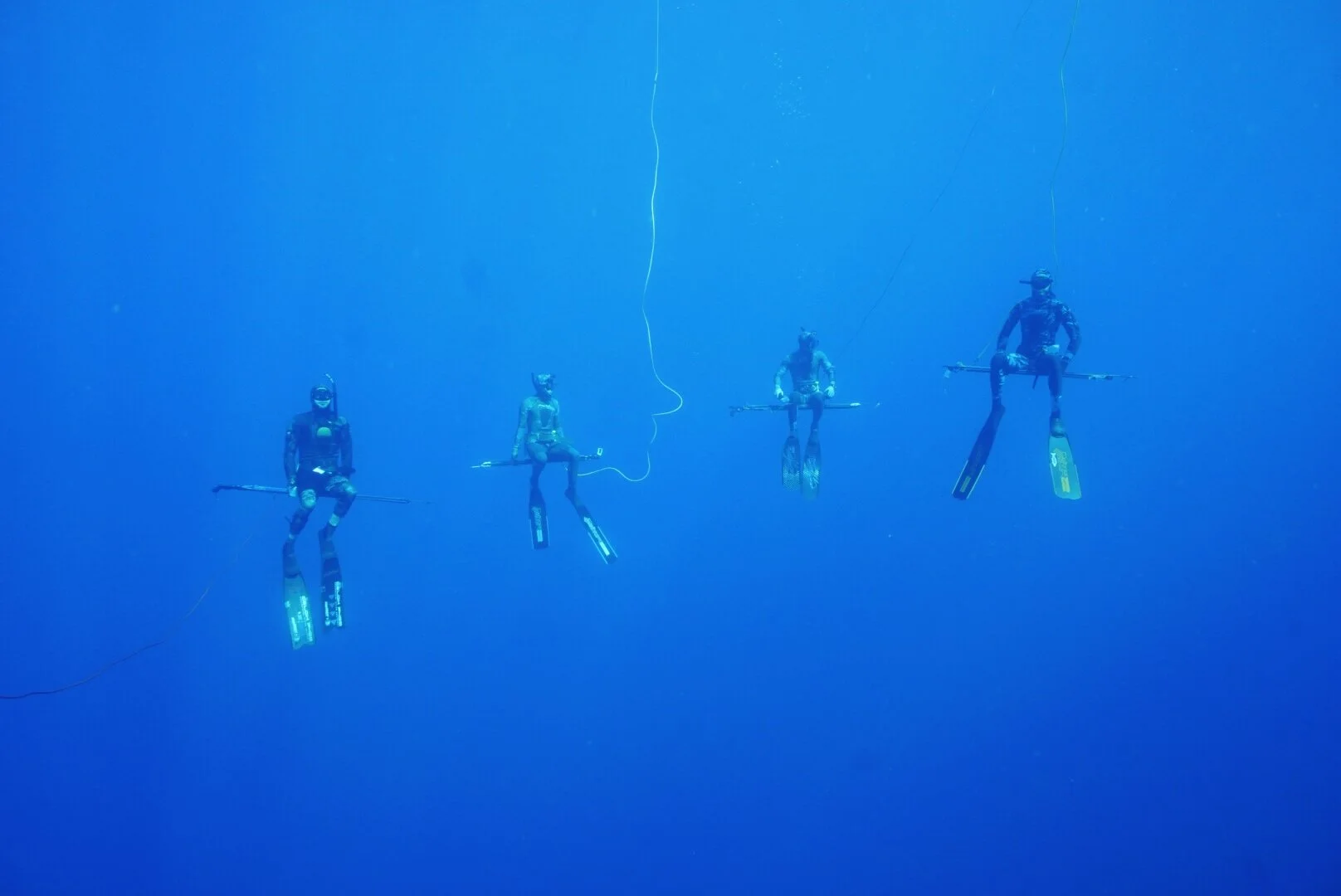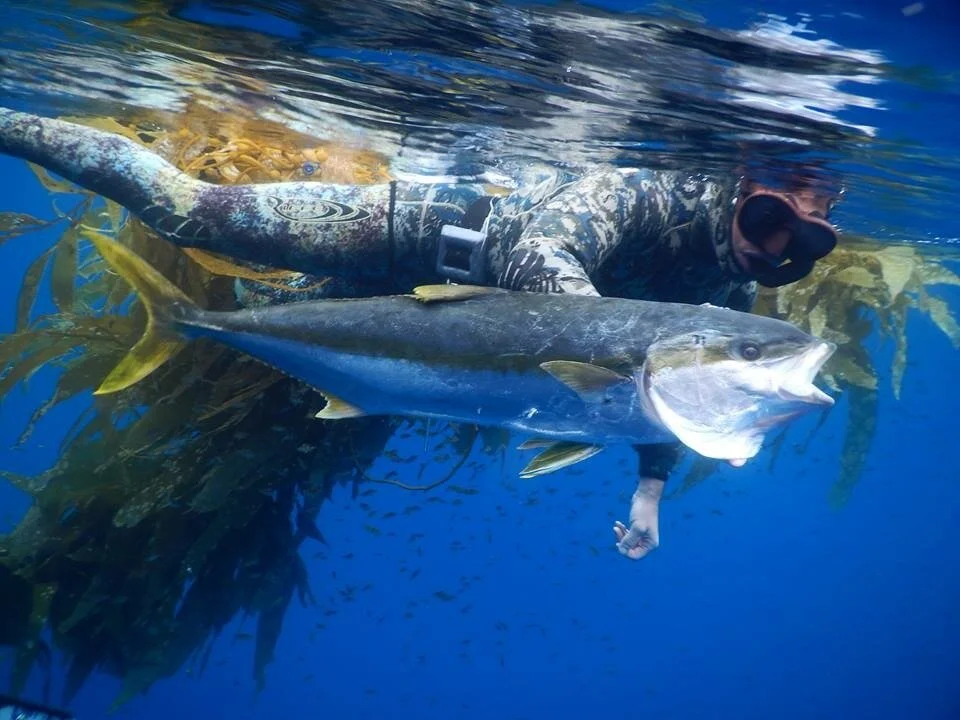Blue Water vs. Reef Spearfishing
Written by Fin + Forage’s, Charlie Robinton
Other Hunting Techniques to Learn:
Agguato (Stalking), Aspetto (Ambushing), Hole Hunting and Interacting with Fish
Spearfishing can be divided into two disciplines depending on the species targeted and the environment you are hunting in. Hunting that takes place close to bottom structure where the targeted fish are mainly resident species is generally referred to as reef spearfishing. Spearfishing offshore in waters of unlimited depth, where target species are open-water, pelagic and migratory fish is called blue water hunting. In some cases, both can take place in the same environment. A great example is Mexico’s Sea of Cortez, where a deep-water trench runs extremely close to shore, bringing large pelagic fish like tuna, wahoo and marlin within sight of the beach in some areas. The Sea of Cortez also has many deep offshore reefs, banks and seamounts that attract both migratory open-water fish and resident reef species. Here skilled freedivers can hunt the blue water and the deep reef in the same location. Each type of spearfishing has its own nuances, and requires a special set of skills, techniques and equipment to be successful. In this article we will give you a basic rundown of both disciplines so that you can be prepared to hunt in any environment.
Reef Spearfishing
Reef spearfishing is engaging and fun. You can find reef environments all over the world, and every place has its own set of resident fish species that will challenge your hunting ability and culinary skills! From beaches and rocky shorelines, to deep boulder gardens, pinnacles and reefs far offshore, the possibilities are only limited by your ability to get to the bottom and hunt effectively.
Equipment
Besides the basic necessities which we’ve written a thorough article covering here, when spearfishing the reef, one of the most important considerations is having the right type of speargun and rigging that will handle whatever fish you are after while being dragged across rocks and/or coral on the bottom. The power or length of the gun will largely depend on the size of fish you are after and whether or not they tend to hold within caves and rocky structures. Shorter guns in the 60-90cm range work best for small to medium sized fish, especially if you will be trying to spear them in the rocks. Longer guns in the 90-120cm range are more appropriate for large, powerful reef fish and even for small fish if the water is very clear or they tend to suspend off the reef structure rather than holding directly on the bottom. There are times and places where spearos will use even larger, more powerful guns in reef environments, but this is generally limited to areas where both reef and bluewater species are present, or when hunting very large groupers and snappers.
Important considerations when purchasing a speargun for reef hunting
A shorter, less powerful gun is ideal for small to medium sized fish and when hunting close to structure.
A long, powerful gun works best for bigger fish or when extra range is needed.
For hunting fish that live in holes and caves, choose a gun with an open track and open muzzle. Enclosed track and closed muzzle guns can be dangerous to fire in places where the spear may not exit the track entirely during the shot. We have a more detailed article on hole hunting here.
Dyneema or Spectra shooting line is incredibly strong and abrasion resistant. It may be a good rigging choice if you are hunting large reef fish close to the bottom. Otherwise, 250-400 pound monofilament works well, but is more vulnerable to nicks and abrasions and must be replaced more frequently.
Reel V.S. Floatline
There are endless debates about which is a better option for spearfishing, and you will hear good arguments for both. The truth is there are advantages and disadvantages to each, so it is up to you to weigh those while thinking carefully about your local environment and fish.
Reel
Reels are attached to your gun and generally will be spooled up with 20-50 meters of strong, abrasion resistant spectra or dyneema. The best part about diving with a reel is the freedom you experience without having anything attached to your speargun. For this reason, reels can be a good option when diving deeper or in strong currents. They are also preferred for diving around wrecks or oil rigs where a floatline can be a hindrance. The main drawback of reels is that they are much less safe than using a floatline. The reel can jam while you are swimming to the surface after shooting a fish, or you can become entangled in the thin reel line during the fight and pulled under. In low visibility there is nothing attached to your gun for your partner to follow and track where you are during a dive. For these reasons, reels should be used with extreme caution and are recommended only for more experienced divers. Even then, they are best left for hunting smaller fish that are easy to control if something goes wrong. If you plan on using a reel when targeting big fish, you must be fully prepared to let go of your speargun and lose it if you experience trouble.
Floatline
Floatlines have been the gold standard in spearfishing for a long time. In the past, a floatline was simply a strong rope with one end fastened to the speargun and the other tied off to a bouy. While this was functional, it may not have been the safest or most convenient option. These days floatlines have come a long way, and are made from all sorts of strong, easy handling materials in an array of colors from camo to high visibility. The advantage of a floatline is its safety and simplicity. When you are using a floatline and shoot a fish that is too big to bring to the surface, you can swim safely to the surface and continue the fight from there using the floatline. If the fish takes a powerful run, you have the freedom to release everything and let your bouy do the fighting until the fish tires. While becoming entangled in a floatline is not impossible, with some awareness and experience it is mostly preventable and not nearly as dangerous as using a reel. For this reason alone many beginner and very experienced divers use them exclusively. A popular use for floatlines is when diving in limited visibility. High visibility floatlines make it easier to track your partner when they are down, keeping you both much safer during a dive. They also give you the option to leave your speargun on the bottom to mark structure or fish so that you can return to the surface for a breath without fear of losing your spot. The only real disadvantage is that diving with a floatline can feel cumbersome at first. It takes a bit of experience to become aware of the floatline while you are diving and keep it from hanging up on your body or surrounding objects. Once you get past this and get more comfortable with a floatline it will rarely be a problem.
For reef hunting it is important to choose a high quality floatline that is strong, abrasion resistant and tangle free. Floatlines with a PVC or vinyl coating are preferred over woven rope and spectra because of these qualities. The line should be no longer than the deepest you will be diving, and it needs to be solid. Some floatlines feature built in stretch or attached “bungee” sections for fighting big fish in open water. We will talk about these in the blue water section, but they are not what you want for the reef. When hunting reef species, especially big ones, you need a strong, solid line that you can use to drag powerful fish up and keep them from hanging up on the bottom or going into holes and caves. A stretchy line will allow big fish to run unrestricted and inevitably get stuck on the bottom.
Skills and Techniques
Reef hunting will test your freediving and fish stalking ability. Because you will be hunting the bottom, you will need to learn to dive deep and stay down for a long time in order to get close to the fish you are after. Taking a freediving class will be a huge step toward becoming more comfortable hunting deep. Developing a training regimen, and learning some dry training practices such as C02 tables is another great way to extend your time on the bottom. Many reef fish are wary of divers, and successfully hunting them involves learning how to interact with them in a non-threatening way. Check out this post on interacting with fish for some helpful tips. Becoming experienced in hunting techniques such as aspetto and agguato will be very important if you plan on doing this type of spearfishing frequently.
Many spearos begin with reef fishing due to ease of access and the presence of fish in shallow nearshore locations, and at some point get the bug to start chasing bigger fish in deeper water. When you begin to feel the pull of the depths and desire to test yourself against the biggest fish in the ocean, it is time to learn about diving in the blue water.
Blue Water Spearfishing
There is nothing quite like drifting in the open ocean miles from the shoreline, not quite knowing what is going to swim out of the deep blue. The mystery and wonder of swimming over water that could be thousands of feet deep and the exhilaration of hunting some of the oceans most awesome predators captures the hearts and minds of the world’s most talented spearfishers. This environment and its fish present some very unique challenges that are important to understand if you want to try hunting in the deep blue.
Equipment
Apart from certain locations in the world where deep water runs adjacent to shorelines, most blue water spearfishing is done off some type of watercraft. Blue water spearos use various boats, kayaks and even jet skis to get to the open ocean areas where migratory fish like to congregate along depth contours and current lines. In most cases, these places are too far to swim, and even when they are not, hazards like ocean currents and boat traffic would make swimming a foolish idea. If you want to try blue water spearfishing and don’t have access to a boat, taking a charter or hiring a private guide is an excellent idea. In any case, having a captain that knows the water and will put you right on top of the fish is very important when learning to spear in the open ocean. Another good option is to join a local spearfishing club. Most clubs have scheduled dives and meetups where you can connect with people to go spearfishing with, and you will have the opportunity to learn with some very experienced divers.
Spearguns for Blue Water
Gun choice is very important if you are serious about bluewater hunting. Just like reef fishing, you will want to consider the species you will be after and the range you will need. Rear handled guns that are 130cm and up or mid handled guns in the 50-70” range are generally needed for taking longer shots on big fish. The larger guns are usually made from hard woods like teak or mahogany and ballasted with lead to keep them balanced for maneuverability and accuracy. These guns will commonly have 3, 4 or even more bands for extra power and range. Many experienced blue water hunters swear by the old adage “bigger is better” when it comes to speargun choice, arguing that you never know what kind of fish you might encounter so you should always be prepared for the fish of a lifetime. There is some definite truth to this statement when hunting in the open ocean, but it is important to consider a gun that you will be able to load easily and swim comfortably with. These attributes will allow you to dive all day and get closer to the fish, which will give you more opportunities in the long run than dragging around an overly huge speargun that you can barely load or aim.
A final point to consider is the spear itself. The most common setup around the world is a flopper shaft, which has a hinged barb a few inches from the tip that swings out after the shot to help keep the fish from escaping. Many blue water spearos prefer a “slip tip” shaft, where the last six inches or so (the point of the spear) is a separate piece, attached to the spear by a short section of wire or spectra line. When the spear penetrates a fish, the tip will come free on the other side, leaving the shaft to swing on the connecting cable and eliminating unwanted leverage from having a solid shaft in the fish.
Once you have your weapon of choice, you will want to attach a floatline and a good float. Many lines for blue water have built in stretch or “bungee” sections that help fight the fish in open water and have some give to prevent your shaft from tearing out during extended battles. For certain larger fish such as bluefin and yellowfin tuna, the entire line should be a bungee that stretches up to three times its original length and features a dyneema core for great strength. These types of lines are expensive, but well worth it when you’ve got the fish of your life on the other end.Your float should be rugged and well made, built to withstand the rigors of saltwater use and the intense pressure of being dragged several atmospheres below the surface during a fight. There are many companies that sell excellent blue water floats specifically for this purpose, and just like floatlines, they are worth the investment.
Techniques
Blue water hunting generally involves shallower diving, although there are exceptions. Pelagic fish are instinctive predators, and naturally curious about anything foreign in their environment. They usually won’t hesitate to come check you out. Sometimes just getting out of the boat and diving down to 20 or 30 feet is enough to bring them in. If not, blue water spearos have all sorts of tricks to aid in attracting fish, including chumming, hand-held throw flashers and line flashers hung from a float.
Attracting fish with chum and flashers
Chumming involves throwing live bait, dead baitfish, or cut up chunks of bigger fish into the water and allowing them to sink to create a trail or “slick” that functions as a highway, bringing fish right to you. Using chum is highly effective at attracting fish, but sometimes attracts the wrong kind of attention. It is best to avoid in areas with heavy shark activity, and leave immediately if sharks come in on the chum. Also, make sure to check local regulations before using chum, as it is not legal everywhere. When diving around chum, stay at the edge of the slick rather than diving right into it. Be patient and let the fish become comfortable feeding before diving down. A good strategy is to judge the trajectory of the fish and select a piece of chum you think it is going to eat. Dive to the level of the chum and wait for the fish to swim up to eat your piece before taking a shot.
Don’t worry if you can’t use chum or don’t have access to any. There are other great ways to attract fish. The most common method blue water spearos use to attract fish is hanging a flasher below a small float. A hanging flasher is a simple device, usually consisting of a lead weight wrapped with flashy, flexible mylar attached to a length of heavy monofilament. Sometimes spearos add small mirrors or other reflective objects every few feet or so along the line to add more attraction. The flasher dangles below the float, bobbing and dancing with the waves, sending reflections of light in every direction. Curious ocean fish usually can’t resist swimming in to see if the reflection is a potential meal.
Throw flashers are hand-held and usually made of plexiglass covered with reflective tape. They are designed to be tossed a short distance and wobble, spin and flash as they sink slowly, resembling an injured baitfish. Blue water hunters often carry them to get the attention of a fish that is cruising outside shooting range and draw it closer.
The most important aspect of becoming a successful blue water hunter is learning to interact with fish when they finally arrive. It is too easy to get lost in the moment and take a long shot or chase after a fish only to be left in the dust. The clear blue water tricks your eye, and it is well known among experienced spearos that fish appear to be much closer than they actually are. Often a hunter will take a shot on a fish they think is in range, only to watch the spear fall well short of the target. If you behave calmly and wait for the fish to approach until you can see detail in its eyes and gill plates you will have the best opportunity for a good shot.
Both blue water and reef hunting each offer their own excitement and challenges. It is important to note that if you are new to either you should seek out the advice of a local shop and look for a club where you can meet experienced buddies to dive with. Having the advantage of experts to learn from and look out for you will keep you safe and cut your learning curve in half.






